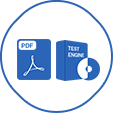Last Update 20 hours ago Total Questions : 80
The SAP Certified Associate - SAP S/4HANA Cloud Private Edition, Production Planning and Manufacturing content is now fully updated, with all current exam questions added 20 hours ago. Deciding to include C_TS422_2023 practice exam questions in your study plan goes far beyond basic test preparation.
You'll find that our C_TS422_2023 exam questions frequently feature detailed scenarios and practical problem-solving exercises that directly mirror industry challenges. Engaging with these C_TS422_2023 sample sets allows you to effectively manage your time and pace yourself, giving you the ability to finish any SAP Certified Associate - SAP S/4HANA Cloud Private Edition, Production Planning and Manufacturing practice test comfortably within the allotted time.
Why do you use Engineering Change Management? Note: There are 2 correct answers to this question.
Which time elements are relevant for lead time scheduling of a production order? Note: There are 2 correct answers to this question.
Mode selection is one of the scheduling options available with Advanced Planning in SAP S/4HANA Cloud Private Edition. When can you use mode selection?
What does a line hierarchy in repetitive manufacturing represent?
What are some SAP-recommended guiding principles to achieve clean core operations? Note: There are 3 correct answers to this question.
Which SAP applications can be used for forecasting in Supply Chain Planning? Note: There are 2 correct answers to this question.
Which actions does the system perform by default when you save a confirmation for a finished product in repetitive manufacturing? Note: There are 3 correct answers to this question.

